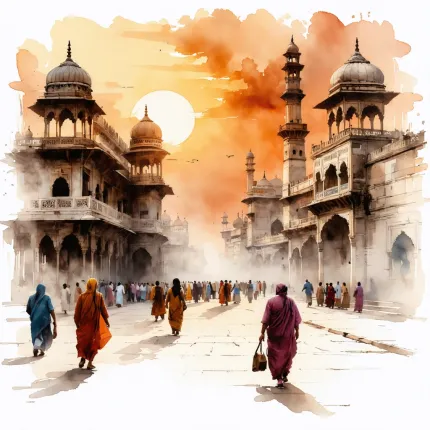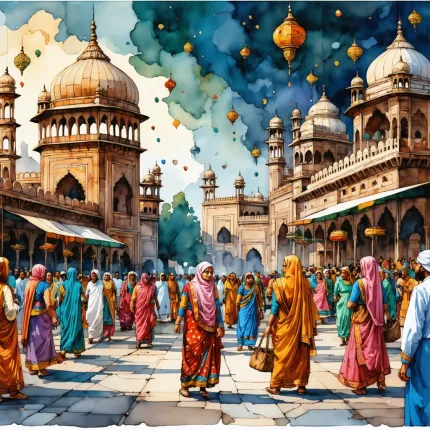
Unraveling the Rich Tapestry of Tradition in a Modern Era
Step into the bustling streets of Old Delhi, where the majestic Jama Masjid Delhi stands not just as an architectural marvel but as a living testament to centuries-old Islamic heritage. Or imagine the serene aura surrounding the Hazrat Nizamuddin Dargah, a spiritual haven that draws countless devotees and seekers alike. These iconic landmarks are more than mere tourist spots—they embody the vibrant cultural practices that continue to shape the lives of India’s Muslim community in 2025.
Yet, as India strides forward into a new decade marked by rapid urbanization, technological advances, and shifting social dynamics, understanding how these age-old customs sustain their significance becomes increasingly complex. How do communities preserve their distinct identity amidst a fast-paced modern world? What role do places like the Gumbad e Khazra play in reinforcing cultural continuity? And how are younger generations engaging with the traditions passed down to them?
These questions resonate deeply because the cultural fabric of India’s Muslims is a mosaic—woven from threads of faith, history, and communal living that defy easy categorization. There is often a misconception that cultural practices are either frozen relics of the past or that they inevitably fade with time. However, the reality observed in 2025 paints a far richer and more dynamic picture.
Why Understanding These Practices Matters More Than Ever
In a country as diverse as India, where religious and cultural identities frequently intersect and sometimes collide, knowing the nuances of each community’s traditions fosters empathy and social cohesion. For policymakers, educators, and social workers, this knowledge is crucial to crafting inclusive initiatives that honor cultural sensitivities while promoting progress.
Consider the daily life around Jama Masjid Delhi: the call to prayer echoing through narrow lanes, families gathering for communal iftars during Ramadan, and artisans selling traditional wares passed down through generations. This isn’t a static tableau but a living, breathing culture adapting to 21st-century challenges.
Moreover, spiritual centers like Hazrat Nizamuddin Dargah do not simply serve religious functions; they act as hubs for music, poetry, and Sufi traditions that influence wider Indian art forms. The Gumbad e Khazra, with its distinct architectural style and historical significance, symbolizes the enduring legacy of Mughal-era Islamic culture, reminding us that heritage is not just about preservation but also about relevance.
What This Article Will Explore
In the sections that follow, we will delve deep into the cultural practices that define India’s Muslim community today. You’ll discover:
- How religious rituals and festivals are observed in contemporary contexts
- The role of heritage sites like Jama Masjid Delhi and Hazrat Nizamuddin Dargah in community life
- Emerging trends in art, cuisine, and social customs that reflect an evolving identity
- Challenges faced by the community in maintaining these practices amid modernization
- Stories of individuals and groups who are bridging tradition with innovation
By the end of this journey, readers will gain not only an appreciation of fascinating cultural nuances but also an understanding of the resilience and creativity that keep these practices alive. Whether you’re a student of culture, a traveler, or simply curious about the mosaic of India’s social landscape, this exploration promises fresh insights and meaningful reflections.
So, join us as we traverse through time and tradition—from the echoing prayers at Jama Masjid Delhi to the soulful melodies near Hazrat Nizamuddin Dargah, and the enduring stones of Gumbad e Khazra—to discover how India’s Muslim community continues to honor its past while embracing the future.

Islamic Cultural Practices in India’s Muslim Community in 2025
Understanding the cultural practices of India’s Muslim community requires a nuanced exploration of religious traditions, social customs, and historical landmarks that continue to shape daily life in 2025. The Indian Muslim population, which constitutes a significant minority, is diverse and influenced by centuries-old heritage combined with contemporary developments. Key sites like Jama Masjid Delhi, Hazrat Nizamuddin Dargah, and Gumbad e Khazra are not only religious centers but also cultural hubs that reflect the evolving identity of Indian Muslims today.
What Are the Core Religious and Cultural Practices Observed by India’s Muslim Community?
Religious observance plays a central role in the cultural life of Indian Muslims. The five pillars of Islam—Shahada (faith), Salah (prayer), Zakat (charity), Sawm (fasting during Ramadan), and Hajj (pilgrimage to Mecca)—are foundational. However, these practices are often interwoven with local customs and regional variations that enrich the cultural landscape.
For instance, communal prayers at Jama Masjid Delhi, one of the largest mosques in India, provide a vibrant social and spiritual gathering space, especially during Eid and Ramadan. This mosque not only facilitates religious rituals but also serves as a place for cultural exchange and community bonding. Similarly, the Hazrat Nizamuddin Dargah, a revered Sufi shrine, exemplifies the syncretic spiritual traditions embraced by many Indian Muslims, highlighting the importance of devotion, music (Qawwali), and pilgrimage in their cultural practices.
- Prayer and Worship: Daily prayers (Salah) are performed individually or communally, with mosques like Jama Masjid Delhi playing a crucial role in bringing people together.
- Festivals: Eid-ul-Fitr and Eid-ul-Adha are celebrated with great enthusiasm, involving special prayers, feasts, and charity.
- Ramadan: Fasting during Ramadan is observed strictly, with iftars often shared in community gatherings.
- Sufi Traditions: Pilgrimage to shrines such as Hazrat Nizamuddin Dargah remains important for spiritual healing and cultural identity.
How Do Historical Monuments Influence Cultural Practices?
Historical monuments like Gumbad e Khazra, known for its architectural significance and spiritual importance, play a vital role in preserving cultural heritage. These sites are not only tourist attractions but also active centers of cultural education and religious practice.
Gumbad e Khazra, an example of Mughal-era architecture, is often visited during religious festivals and commemorative events. These visits reinforce community ties and provide a tangible connection to the rich history of Islam in India. The preservation and continued use of such monuments help the Muslim community maintain a strong sense of identity and continuity amidst rapid societal changes.
What Social and Cultural Trends Are Emerging Among Indian Muslims in 2025?
In 2025, India’s Muslim community continues to balance tradition with modernity. Education and economic participation have been rising, leading to greater representation in various professional fields. This shift impacts cultural practices by encouraging more inclusive and diverse expressions of Islamic identity.
Digital platforms and social media are increasingly used to disseminate religious knowledge, organize events around places like Jama Masjid Delhi and Hazrat Nizamuddin Dargah, and foster inter-community dialogue. Additionally, younger generations are exploring their heritage with renewed interest, often blending traditional customs with contemporary lifestyles.
- Education and Empowerment: Increased literacy rates and educational attainment influence cultural participation and religious understanding.
- Interfaith Engagement: Events at sites like Hazrat Nizamuddin Dargah promote harmony and cultural exchange beyond religious boundaries.
- Urbanization Effects: Migration to cities leads to adaptations in cultural practices, such as more public celebrations and community centers.
Why Is It Important to Understand These Cultural Practices?
Comprehending the cultural practices of India’s Muslim community fosters social cohesion, reduces stereotypes, and promotes mutual respect. It also provides insight into the community’s contributions to India’s pluralistic society and helps policymakers, educators, and social workers create inclusive environments.
Furthermore, recognizing the significance of landmarks like Jama Masjid Delhi, Hazrat Nizamuddin Dargah, and Gumbad e Khazra enriches heritage tourism and encourages preservation efforts that benefit both the Muslim community and the nation as a whole.
Frequently Asked Questions (FAQs)
How do Jama Masjid Delhi and Hazrat Nizamuddin Dargah influence daily life?
Both sites serve as spiritual centers and social hubs, hosting religious ceremonies, educational programs, and cultural festivals that reinforce community bonds and preserve traditions.
What is the significance of Gumbad e Khazra in Muslim cultural heritage?
Gumbad e Khazra is an architectural monument that symbolizes Mughal-era Islamic art and serves as a site for religious gatherings, thus connecting historical legacy with contemporary practice.
Are there unique cultural practices among Indian Muslims different from other Muslim populations?
Yes, Indian Muslims often blend Islamic traditions with local customs, such as specific styles of dress, cuisine, language dialects, and celebration methods, creating a distinct cultural identity within the broader Muslim world.


